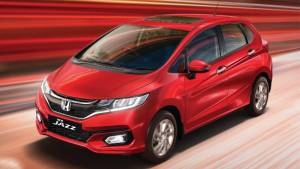The Maruti Dzire takes on its most potent rival ever, the Honda Amaze

The Dzire has won every comparison test in OVERDRIVE. Even last month, after driving to Goa and back in six entry level diesel sedans, we came to the conclusion that the Maruti is the undisputed champion. However things change, and after a long wait Honda has now joined the party with the Amaze, the first big challenger to the Dzire. Should Maruti be worried? We pitch both the cars in a head-to-head contest to find out just that.
Styling and Interior
Both cars are based on hatchbacks but look at both cars and one will find the Amaze more proportionate, the boot isn't stubby like in the Dzire and both ends of the car look like they belong to each other. The Maruti stands taller and is wider but the Amaze has a better defined side with a longer rear overhang. We only wish Honda offered larger 15-inch wheels with thicker rubber like in the Dzire, all variants get 175-section 14-inch tyres in the interest of fuel economy but ends up looking skinny. Inside, both cars feature dual-tone black/beige interiors but it's the Dzire that feels more premium. The Brio interiors in the Amaze go well with the hatchback's fun theme but in the sedan we expected to see a more upmarket look and better finish.
There is not much to choose between the two cars up front, both cars offer seat height adjustment in the top variants and good support. The biggest drawback of the Dzire however is rear cabin and boot space. The Amaze is a shorter in terms of length and wheelbase, so one would expect the car to offer similar or even lesser space. However smarter space management and scooped out front seats has resulted in a more spacious cabin. To give a better picture, the Maruti offers a maximum of 860mm of rear kneeroom while the Amaze offers an incredible 70mm more (similar to larger cars like the Honda City). The Honda even offers a larger glass area for the rear passengers while the boot is also more spacious. At 400 litres, it is a full 75 litres more than the Dzire.
Engine and performance
The Amaze features a larger 1.5-litre i-DTEC engine in comparison to the 1.3-litre DDiS unit in the Dzire. This helps it produce more power. While the Dzire produces 75PS at 4000rpm and 190Nm at 2000rpm, the Amaze puts out 100PS at 3600rpm and 200Nm of torque from as low as 1750rpm. Crank the motor and it's the Dzire that sounds more refined, the Amaze isn't louder but the diesel clatter is more prominent and we think Honda could have improved cabin insulation. On the road, the Amaze puts down power in a more linear fashion, there is hardly any turbo lag resulting in better drivability than the Dzire. The high torque produced at a lower rpm helps the Amaze effortlessly pull from low speeds despite being in a higher gear. Both the cars offer a five-speed gearbox, the Dzire offers smoother shifts but the throws are shorter in the Amaze. In terms of straight line performance, the Amaze is the quicker car. 100kmph come up in 13.3s while the quarter mile is covered in 18.78s (quicker to the Dzire by 0.86s and 0.42s). The Amaze can be even quicker in acceleration but since the engine can't be revved beyond 2000rpm with the clutch pressed, the car is slow to launch. When it comes to top speed, the Amaze is much slower than the Dzire. The car is quick to reach 141kmph but doesn't go beyond this speed. Like in the Brio the top speed seems to be limited. In terms of efficiency, the Amaze returns little more to the litre despite being more powerful. In town the car returns 15.86kmpl while on the highway the figure goes upto an impressive 23.98kmpl resulting in an overall figure of 17.89kmpl (0.56, 0.09 and 0.89kmpl more than the Dzire respectively). The Dzire has a longer range though due to a larger 42-litre tank compared to the Amaze's 35-litre tank.
Ride and Handling
Both cars feature a MacPherson unit up front and a torsion beam at the rear but are tuned differently. The Dzire has been the best handling car in the segment and continues to be so, the setup is neither too stiff nor soft while the ride is quite good even on rough roads. The Amaze in comparison is softer and the ride does get bumpy especially at higher speeds. However the Honda is still is quite good around corners but not as good as the Dzire. The Maruti also has an advantage since the top ZDi variant runs on wider 185-section tyres. In town, both cars offer a comfortable ride and either of the two make for a good choice. The Amaze is easier to negotiate through traffic and even boasts of a smaller 4.7m turning radius compared to the Dzire (4.8m).
Features
The Amaze diesel is available in four variants with all of them offering standard ABS (Maruti take note) while the Dzire diesel is available in three variants with only the top ZDi model getting standard ABS. There is no auto climate control in the Amaze while the stereo in the top models doesn't support CD input. The Amaze misses out on simple features like a front seatbelt height adjuster but the top-end model offers unique segment first features like a heat absorbing windshield and electronically foldable mirrors.
Verdict
The ideal entry level sedan is expected to offer great value, performance and at the same feel like a step up from a bigger hatchback. The Dzire ticks everything in the check list but is disappointing when it comes to interior space. The Amaze solves this problem by offering much more cabin and boot space and at the same time offer better performance, economy and standard safety features for almost the same price as the Maruti. The base Amaze diesel is priced at Rs 6.49 lakh, ex-Mumbai making it just Rs 8000 more than the equivalent Dzire. The Dzire is then dethroned for the very first time and hands over the entry sedan crown to the Honda Amaze.
Starts Rs 6.32 Lakhs
1498cc
Manual
90
200
21 Kmpl
Starts Rs 10.9 Lakhs
1497cc
Manual
100
145
17.8 Kmpl
-NA-
1248cc
Manual
-NA-
190
26.59 Kmpl














